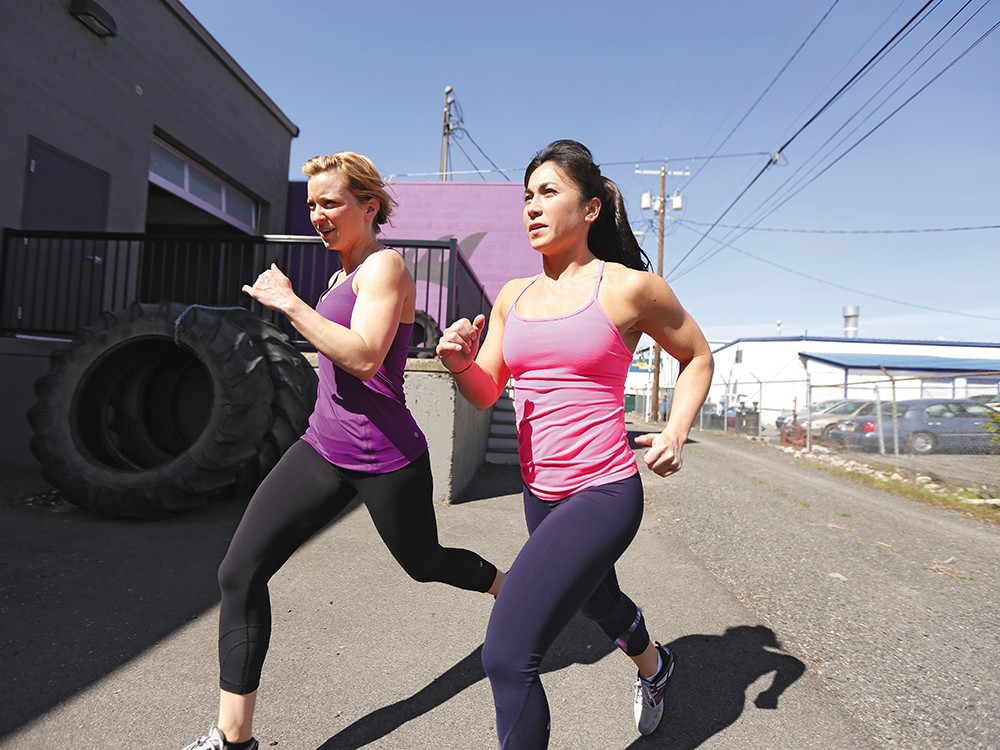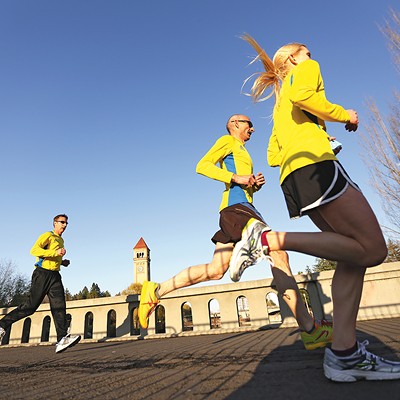
The Farmgirlfit gym is based on an adaptation of the popular fitness craze Crossfit, which owner Jenni Niemann has modified to fit the demands of the modern woman. It’s a women’s gym, free of sweaty bros in tank tops and geared toward getting women comfortable with lifting aggressively. Niemann — who received her degree in exercise science from Gonzaga University and has a Crossfit Level 1 Certification and USA Weightlifting Performance Coach Certificate — also teaches endurance training and has some tips on how to turn yourself into a runner.
So you want to start running:
Niemann starts with form.
“No matter the shoes, the speed, the distance, without a focus on form you’ll hate running,” she says.
To work on form, start with a mix of walking and running. Throughout the running segments of your workout, focus on keeping your foot strikes as “quiet as possible.” This emphasis prevents you from pounding the pavement and angles your posture forward, allowing you to land on the midsole and not the heel of your foot.
Once you’ve gotten your form down, here’s the beginner’s workout. Start by marking out an 800-meter loop, approximately two city blocks. The idea is to sprint half a block and then walk. At each intersection do 10 repetitions of body weight exercise: push-ups, lunges, squats or planks. This combination of sprints, walking and exercises forces your heart rate to spike then drop repeatedly. This cycle increases both aerobic and anaerobic fitness, enabling you to see results faster.
Niemann also suggests timing yourself. The goal after the first run is to always beat the previous run, “even if it is only a few seconds.” Timing allows you to see improvements and gives you a clear goal.
So you want to run Bloomsday:
If you’re just reading this now it might be too late to get fit by Sunday, but here are some tips for next year. You need to start running farther and work on muscle imbalances. This means incorporating more anaerobic exercises such as weight training. Niemann explains that if you only run long distances, you only develop running-specific muscles, neglecting the muscle groups that stabilize your body.
A Bloomsday-specific workout to balance muscles and make sure you’re strong for that mid-race Doomsday Hill would be hill repeats, step-ups, stairs and anything else that resembles the motion of running uphill. You don’t need a gym to do these exercises, either. Next time you run past a park bench, stop in front of the bench and step up onto it using your right foot. Once you reach your maximum height, slowly drop back to the ground and then step up with your left foot. Repeat 20 times, 10 for each leg.
Niemann also provided an example of how to keep yourself accountable if you’re training solo. She says that for every goal you set for yourself — a 3-mile run with no walking — you need to have consequences. If you break your goal, you need a punishment, maybe running an extra mile on an off day. The consequence keeps you motivated to accomplish the task at hand.
So you want to become a marathoner:
Niemann provided us with two areas on which to focus: 1) Developing muscles in the back of the legs; and 2) Establishing a stretching routine.
Weightlifting is more important for longer distances. As mileage increases, so does wear on the body. A typical runner develops strong quadriceps but neglects hamstrings, leading to injuries. To get your body strong for Mile 20, you need to focus on powerful lower-body movements: squats, step-ups, dead lifts and box jumps. Weights should be done two to three times a week.
In the midst of training, muscles tighten and break down. To combat aches and pains, it is important to stretch. Niemann suggests a regimen of stretching, yoga, massage and foam rolling, which involves lying on a large foam cylinder and applying pressure to specific parts of your body, massaging muscle fibers and flushing out toxins.
Niemann’s last piece of advice: Use other runners for motivation. Keep your eyes focused 20 to 40 yards ahead. Pick out a person in a bright shirt and don’t take your eyes off them. Once you’ve passed them, pick a new target.
















